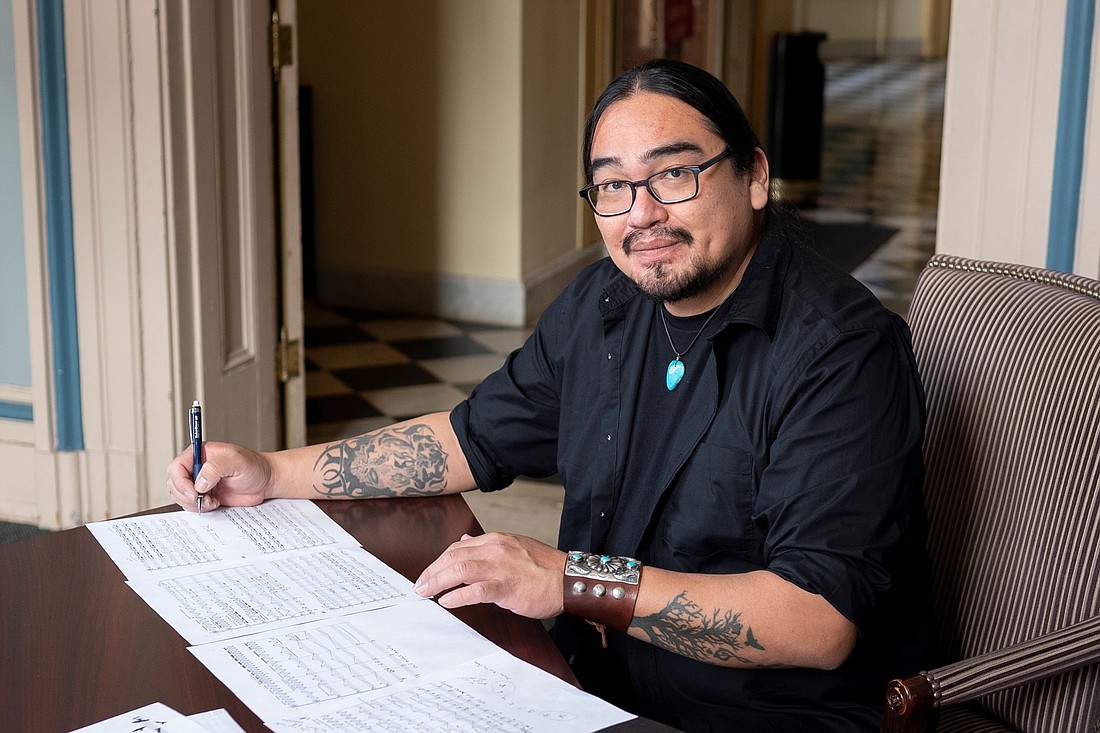- April 25, 2024
-
-
Loading

Loading

Art is a moving target. It evolves and changes from day to day.
Trying to pinpoint what’s happening now is like trying to capture lightning in a bottle. But that’s the prime directive of EnsembleNewSRQ. This innovative ensemble celebrates the ongoing evolution of classical music.
What’s the next evolutionary leap? Violinist Samantha Bennett and percussionist George Nickson are the group’s founders and co-artistic directors. On Oct. 10, they’ll be answering the question with a concert.
“First Voices” revolves around the voices of living, Indigenous composers.
It’s all new work. The voices of today, not the past.
Here are the voices you’ll hear.
Jerod Impichchaachaaha’ Tate is a Chickasaw classical composer.
He created this tempestuous piece for solo timpani — and it’s stormy indeed.
“Hiloha” is Chickasaw word for thunder and lightning. Traditionally, the Chickasaw people believed thunderstorms meant that the holy people above the clouds had gone to war. When a raging storm crossed the plains, Chickasaw warriors would ride out and fire their rifles at the sky to prove their bravery.
Tate’s composition summons the tempest with five enormous kettledrums and celebrates the history of his people.
Performer: Percussionist George Nickson.
“Imago” refers to the penultimate stage of an insect’s metamorphosis.
In figgis-vizueta’s sonic tapestry, it’s a cicada. It’s a complex work, dense with patterns and cycles.
String instruments vibrate with the cicada’s relentless rhythms, and then slow to near silence. Other patterns evoke birds and beasts — and the sense of being joyfully outside in nature.
figgis-vizueta created this work during the time Covid forced her to be a shut-in.
The Andean composer notes that, “‘Imago’ is my response to artworks that, due to the pandemic, I couldn’t see or interact with in real life.”
Performers: Violinists Samantha Bennett and Jennifer Best Takeda; violist Alex D’Amico; cellist Clare Monfredo.
Ogonek’s composition recalls the polyphonic density of Ligeti’s “Atmosphères,” but it’s uniquely her own. This piece for violin, piano, clarinet and percussion has a restless, rat-a-tat rhythm that never settles into a predictable groove.
While Ogonek’s work has a relentless pace, she never rushes the process of composition.
“It becomes a puzzle that I have to solve in some way,” she says. “It’s a long process of uncovering the many ways something could work. There’s blood and tears involved, usually. And sleepy nights and grumpy moods. You don’t want to be my partner.”
Performers: Conductor George Nickson; violinist Samantha Bennett; pianist Jesse Martin; clarinetist Bharat Chandra; percussionist Marcelina Suchocka.
This Diné composer’s roots are in the Navajo Nation of northern Arizona.
His piece captures the seasonal shift from fall to winter. According to Bennett, Begay used a clever musical technique to evoke darkening days and falling temperatures.
“Three of the four string instruments are tuned lower,” she says. “It’s a technique called 'scordatura,' and it gives a colder, spookier resonance to the sounds of the instrument.”
She adds that the enSRQ audience has a good ear for contemporary classical music.
“The effect is almost subliminal,” she says. “But most of our listeners will notice it.”
Performers: Violinists Samantha Bennett and Jennifer Best Takeda; violist Alex D’Amico; cellist Clare Monfredo.
This work for percussion, string quartet and electronics is a moveable feast of sound. The Mexican composer, Gabriela Ortiz, took inspiration from the city of Los Angeles, and its multiplicity of Mexican restaurants.
Why L.A. and not Mexico City?
“Los Angeles is a sui generis universe of culinary venues where borders are diluted in a great multiculturality,” she says. “This city is a fascinating product of globalization and mass migration — and the perfect place to explore the development and impact of Mexican food in a foreign context.”
Performers: Violinists Samantha Bennett and Jennifer Best Takeda; violist Alex D’Amico; cellist Clare Monfredo; percussionist George Nickson.
And that’s what you’ll hear at the “First Voices” concert.
Begay, figgis-vizueta, Tate, Ogonek, Ortiz.
Five voices. Five not-so-easy pieces.
Does enSRQ’s concert of their work capture the sonic electricity?
Having heard most of these compositions on YouTube and SoundCloud, my answer is a definite “Yes.”
According to Bennett, these works are a trip — metaphorically.
“You’re not traveling physically,” she says. “You sit in the same room. But the songs transport you to different places, different feelings and different sources of inspiration.”
Nickson adds that representing the voices of Indigenous composers is an idea whose time is long overdue.
“First Voices” does just that. But the music itself always comes first.
“We’re not checking cultural boxes in this concert,” he says. “So many Indigenous composers are creating fantastic music today. The voices you’ll hear in this concert are just a sample. The music is new; the music is good — and that’s why or audience needs to hear it. That’s the core of enSRQ’s mission — and the heart of our programming decisions.”